International Journal of Intelligent Systems and Applications @ijisa
Статьи журнала - International Journal of Intelligent Systems and Applications
Все статьи: 1203
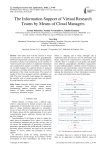
The information support of virtual research teams by means of cloud managers
Статья научная
The article deals with the creation of virtual research teams of scientists from various geographically distributed organizations united for joint interdisciplinary researches. Library social institutions are the satellites of virtual research teams and have to implement information and communication support of scientific researches. The use of cloud managers by academic libraries is proposed as platforms to facilitate remote collaborative work of the participants of the virtual research teams. The research of number of free cloud managers and their capabilities was held. The most successful cloud manager for supporting the scientific work of virtual research teams was selected by using hierarchy analysis method.
Бесплатно

Статья научная
The subject matter of the article is developing information and communication network (ICN) for critical infrastructure systems (CIS). The aim of the work is to provide high-quality information and telecommunication processes by developing the optimal version of distributing CIS functional tasks and ICN processes to the network nodes. The article deals with following problems: developing a model for mapping the information and technical ICN structures, developing a method for variant synthesis of ITS structural models, a formalized representation of the problem of selecting CIS optimal structure. The methods used are: the system method, the set-theoretic and graphic analytic approaches, methods of hierarchic structures synthesis, optimization methods. The following results were obtained: the use of system approach for formalizing the information processing process in CIS was justified; mapping the ICS functional system into the information and technical one was presented as multilevel graph chain; the generalized representation of graph structures hierarchy was developed for the set of data transmitting tasks; this approach enabled formal representing alternative variants that consider the main links, sequencing, the amount and flows of the processed information among the different structure levels; the scheme of variant synthesis method of ICN models according to graph structures mapping was developed; the problem of selecting optimal ICN structures was formally presented; a complex efficiency criterion for solving problems of optimizing variant synthesis of structures; the problem of optimal synthesis of the structure of the given level factored in resource constraints was formulated. Conclusions. The article deals with such novelty aspects as improving the model of problem of selecting the optimal ICN structure by set-theoretic formalization factored in the criterion of maximum intensity of computational resource application, which enabled determining structural links among the major elements considering the decomposition of the model up to the basic elements such as "node" and "task" and the development of a new method of optimal ICN structuring which unlike the existing ones involves the variant synthesis of structures hierarchy and formalizing selection problems on the basis of set-theoretic models, which enables providing the efficiency of application of information and technical net resources.
Бесплатно
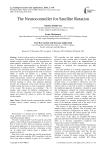
The neurocontroller for satellite rotation
Статья научная
In this work an analysis of neurocontrollers is given. The purpose of this paper is the neurocontroler for attitude control: satellite rotations. The classification of neurocontroller architecture is provided. The pros and cons of different neurocontrollers are described. Two configuration of neural network – feedforward neural networks with mini-batch descent and modified Elman neural network, are investigated in this work to verify its ability to control the attitude of a satellite. The advantages and disadvantage of different predictive model neurorization systems are described. The class diagram for the simulating of satellite rotation for neural network learning is given. The proposed approach provides the architecture of the neural network and the weights among the layers in order to guarantee stability of the system. The accuracy was calculated. The AI module, after trained for different configurations of wheels, will get commands with desired 3D rotation speeds and control the wheels to achieve the desired rotation speeds.
Бесплатно
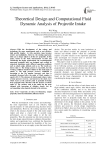
Theoretical Design and Computational Fluid Dynamic Analysis of Projectile Intake
Статья научная
With the development of the science and technology, the more requirements such as cost effective, high specific impulse in wide operation rang, becomes stricter and multiplicity. However, the existing supersonic inlet can no longer adjust to all the new projectiles. In this paper, based on the basic characteristic of inlet and considering the design requirements, the two-dimensional supersonic projectile inlet was designed and verified by numerical simulation under different operating conditions such as attack angle, altitude, and so on. The results are shown that: 1) The design process is successful, but the working conditions should be limited to the small angle of attack; 2) The total pressure recovery coefficient is increasing as the Ma number increases, and then is gradually decreased after the point of Mach number is equal to 0.5; 3) The existence of attack angle reduces values of total pressure recovery. And moreover, the shock wave which occurs at the anterior point is gradually deviating from projectile body direction with the increase of attack angle; 4). The variance ratio in the outlet has the acute changed with increasing of altitudes clearly, but its corresponding values degrade sharply in the entrance.
Бесплатно
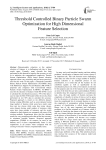
Threshold controlled binary particle swarm optimization for high dimensional feature selection
Статья научная
Dimensionality reduction or the optimal selection of features is a challenging task due to large search space. Currently, many research has been performed in this domain to improve the accuracy as well as to minimize the computational complexity. Particle Swarm Optimization (PSO) based feature selection approach seems very promising and has been extensively used for this work. In this paper, a Threshold Controlled Binary Particle Swarm Optimization (TC-BPSO) along with Multi-Class Support Vector Machine (MC-SVM) is proposed and compared with Conventional Binary Particle Swarm Optimization (C-BPSO). TC-BPSO is used for the selection of features while MC-SVM is used to calculate the classification accuracy. 70% of the data is used to train the MC-SVM model while the test has been performed on rest 30% data to calculate the accuracy. Proposed approach is tested on ten different datasets having varying difficulties such as some datasets having large number of features while some have small, some have just two classes while some have many classes, some datasets having small number of instances while some have large number of instances and the results obtained on these datasets are compared with some of the existing methods. Experiments show that the obtained results are very promising and achieved the best accuracy in minimum possible features. Proposed approach outperforms C-BPSO in all contexts on most of the datasets and 3-4 times computationally faster. It also outperforms in all context when compared with the existing work and 5-8 times computationally faster.
Бесплатно
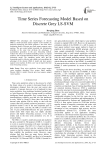
Time Series Forecasting Model Based on Discrete Grey LS-SVM
Статья научная
The advantages and disadvantages of discrete GM(1,1) model and least squares support vector machine are analyzed respectively, this article proposes a new time series forecasting model of discrete grey least squares support vector machine. The new model adopts structural risk minimization principle, at the same time develops the advantages of accumulation generation in the grey forecasting method, weakens the effect of stochastic-disturbing factors in original sequence, and avoids the theoretical defects existing in the grey forecasting model. The simulation results show that the forecasting model is effective and reliable, and consolidates the advantage of the discrete GM(1,1) model and least squares support vector machine. It offers a new way to improve the time series forecasting accuracy.
Бесплатно
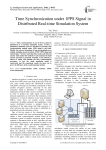
Time Synchronization under 1PPS Signal in Distributed Real-time Simulation System
Статья научная
Time synchronization is one of the key points in distributed of a real-time simulation system. At first, a distributed simulation system is introduced. Secondly, time synchronization method under 1PPS signal is put forth. Thirdly, the relevant technology of time synchronization are studied, including system structure, SNTP, 1PPS signal and control logic. Vxworks watch dog timer mode and timecard counter mode under this method are also analyzed in detail and the precision is presented. Fourthly, Arena software is chosen to model and simulate the time synchronization procedure. At last, the whole simulation model is constructed and the experiment results are given out to prove the efficiency of the synchronization method.
Бесплатно
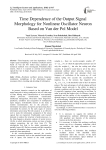
Статья научная
Time-frequency and time dependence of the output signal morphology of nonlinear oscillator neuron based on Van der Pol model using analytical and numerical methods were investigated. Threshold effect neuron, when it is exposed to external non-stationary signals that vary in shape, frequency and amplitude was considered.
Бесплатно
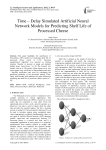
Статья научная
This paper highlights the significance of Time-Delay ANN models for predicting shelf life of processed cheese stored at 7-8oC. Bayesian regularization algorithm was selected as training function. Number of neurons in single and multiple hidden layers varied from 1 to 20. The network was trained with up to 100 epochs. Mean square error, root mean square error, coefficient of determination and nash - Sutcliffe coefficient were used for calculating the prediction capability of the developed models. Time-Delay ANN models with multilayer are quite efficient in predicting the shelf life of processed cheese stored at 7-8^oC.
Бесплатно
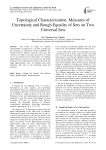
Статья научная
The notion of rough set captures indiscernibility of elements in a set. But, in many real life situations, an information system establishes the relation between different universes. This gave the extension of rough set on single universal set to rough set on two universal sets. In this paper, we introduce rough equality of sets on two universal sets and rough inclusion of sets employing the notion of the lower and upper approximation. Also, we establish some basic properties that refer to our knowledge about the universes.
Бесплатно
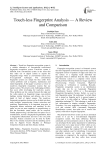
Touch-less Fingerprint Analysis — A Review and Comparison
Статья научная
Touch-less fingerprint recognition system is a reliable alternative to conventional touch-based fingerprint recognition system. Touch-less system is different from conventional system in the sense that they make use of digital camera to acquire the fingerprint image where as conventional system uses live-acquisition techniques. The conventional fingerprint systems are simple but they suffer from various problems such as hygienic, maintenance and latent fingerprints. In this paper we present a review of touch-less fingerprint recognition systems that use digital camera. We present some challenging problems that occur while developing the touch-less system. These problems are low contrast between the ridge and the valley pattern on fingerprint image, non-uniform lighting, motion blurriness and defocus, due to less depth of field of digital camera. The touch-less fingerprint recognition system can be divided into three main modules: preprocessing, feature extraction and matching. Preprocessing is an important step prior to fingerprint feature extraction and matching. In this paper we put our more emphasis on preprocessing so that the drawbacks stated earlier can be removed. Further preprocessing is divided into four parts: first is normalization, second is fingerprint Segmentation, third is fingerprint enhancement and last is the core point detection. Feature extraction can be done by Gabor filter or by minutia extraction and the matching can be done by Support Vector Machine or Principal Component Analysis and three distance method.
Бесплатно
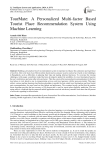
Статья научная
Building a personalized travel recommendation system is important to enhance the satisfaction and experience of travelers. Due to the lack of an efficient online-based tourist assistance system, tourists have faced several challenges in Bangladesh, such as difficulties in planning their trips and making informed decisions. To overcome the existing challenges, in this paper, a prediction model has been developed to predict the suitability of a travel destination based on the user’s preferences and some other relevant factors. Then the system offers personalized recommendations for the best local places to visit, hotels to stay in, transportation services, and travel agencies with the necessary details. This paper utilizes various machine learning classification algorithms to predict the best-suited travel destinations and local tourist spot recommendations for users based on their budget and preferences. The examined results verified that the random forest algorithm provides the best accuracy of 98 percent and is used for tourist place eligibility prediction. The user rating analysis visualized that the proposed mobile application received satisfactory remarks from more than 60 percent of reviewers regarding its effectiveness.
Бесплатно
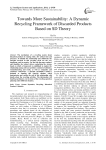
Towards More Sustainability: A Dynamic Recycling Framework of Discarded Products Based on SD Theory
Статья научная
The mechanism of a recycling system about discarded products is running with a few critical roles and processes. To identify the relationship and collaborate the activities involved in this recycling circle are the very significant work in practice. For the sake the paper explores and identifies the critical drivers underlying the system, based on which a framework is established to explore the relationship among relevant activities consisted of collection, remanufacturing and resale, as well as companies and customers’ behaviours. A dynamic quantitative model is designed to simulate this vigorous relation, which demonstrates and verifies the rule of this relationship with details about the recycling activities. The information will benefit practitioners a lot in terms of the recycling operation planning under different situation.
Бесплатно

Towards an Efficient Big Data Indexing Approach under an Uncertain Environment
Статья научная
It is generally accepted that data production has experienced spectacular growth for several years due to the proliferation of new technologies such as new mobile devices, smart meters, social networks, cloud computing and sensors. In fact, this data explosion should continue and even accelerate. To find all of the documents responding to a request, any information search system develops a methodology to confirm whether or not the terms of each document correspond to those of the user's request. Most systems are based on the assumption that the terms extracted from the documents have been certain and precise. However, there are data in which this assumption is difficult to apply. The main objective of the work carried out within the framework of this article is to propose a new model of data service indexing in an uncertain environment, meaning that the data they contain can be untrustworthy, or they can be contradictory to another data source, due to failure in collection or integration mechanisms. The solution we have proposed is characterized by its Intelligent side ensured by an efficient fuzzy module capable of reasoning in an environment of uncertain and imprecise data. Concretely, our proposed approach is articulated around two main phases: (i) a first phase ensures the processing of uncertain data in a textual document and, (ii) the second phase makes it possible to determine a new method of uncertain syntactic indexing. We carried out a series of experiments, on different bases of standard tests, in order to evaluate our solution while comparing it to the approaches studied in the literature. We used different standard performance measures, namely precision, recall and F_measure. The results found showed that our solution is more efficient and more efficient than the main approaches proposed in the literature. The results show that the proposed approach realizes an efficient Big Data indexing solution in an Uncertain Environment that increases the Precision, the Recall and the F_measure measurements. Experimental results present that the proposed uncertain model obtained the best precision accuracy 0.395 with KDD database and the best recall accuracy 0.254 with the same database.
Бесплатно
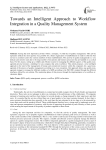
Towards an Intelligent Approach to Workflow Integration in a Quality Management System
Статья научная
Among the most important activities within a company we find that of quality management. This activity represents reflects the most rigorous way possible for a better organization of establishments in order to offer the best service to customers and to the various members of these establishments. This activity of quality management is a very delicate and sensitive task due to the large number of documents and business processes that are handled on a cyclical basis. For this reason, setting up a reliable and efficient system for managing the different aspects of the quality management process becomes a challenge for any company that seeks excellence. This article proposes a new intelligent approach to the need of the management of human and commercial resources within the companies for a good management of the process of quality management according to its own conception. Our approach allows any quality management manager to manage the different modules of a QMS according to the ISO 9001 standard through the different interfaces offered by our solution. The monitoring phase of this process through the implementation of a workflow orchestrator, jBpm.
Бесплатно
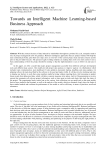
Towards an Intelligent Machine Learning-based Business Approach
Статья научная
With the constant increase of data induced by stakeholders throughout a product life cycle, companies tend to rely on project management tools for guidance. Business intelligence approaches that are project-oriented will help the team communicate better, plan their next steps, have an overview of the current project state and take concrete actions prior to the provided forecasts. The spread of agile working mindsets are making these tools even more useful. It sets a basic understanding of how the project should be running so that the implementation is easy to follow on and easy to use. In this paper, we offer a model that makes project management accessible from different software development tools and different data sources. Our model provide project data analysis to improve aspects: (i) collaboration which includes team communication, team dashboard. It also optimizes document sharing, deadlines and status updates. (ii) planning: allows the tasks described by the software to be used and made visible. It will also involve tracking task time to display any barriers to work that some members might be facing without reporting them. (iii) forecasting to predict future results from behavioral data, which will allow concrete measures to be taken. And (iv) Documentation to involve reports that summarize all relevant project information, such as time spent on tasks and charts that study the status of the project. The experimental study carried out on the various data collections on our model and on the main models that we have studied in the literature, as well as the analysis of the results, which we obtained, clearly show the limits of these studied models and confirms the performance of our model as well as efficiency in terms of precision, recall and robustness.
Бесплатно
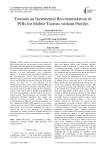
Towards an incremental recommendation of POIs for mobile tourists without profiles
Статья научная
Mobile tourism or m-tourism can assist and help tourists anywhere and anytime face the overload of information that may appear in their smartphones. Indeed, these mobile users find difficulties in the choice of points of interest (POIs) that may interest them during their discovery of a new environment (a city, a university campus ...). In order to reduce the number of POIs to visit, the recommendation systems (RS) represent a good solution to guide each tourist towards personalized paths close to his instantaneous location during his visit. In this article, we focus on (1) the detection of the spatiotemporal context of the tourist to filter the POIs and (2) the use of the previous notations of the places. These two criteria make it possible to integrate the evolutionary context of the visit in order to predict incrementally the most relevant transitions to be borrowed by the tourists without profile. These predictions are calculated using collaborative filtering algorithms that require the collection of traces of tourists to better refine the recommendation of POIs. In our software prototype, we have adapted the SLOPE ONE algorithm to our context of discovering the city of Chlef to avoid problems like data scarcity, cold start and scalability. In order to validate the use of this prototype, we conducted experiments by tourists in order to calculate indicators to assess the relevance of the recommendations provided by our system.
Бесплатно
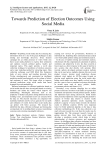
Towards prediction of election outcomes using social media
Статья научная
Exploiting social media data by extracting key information from it is one of the great challenges in data mining and knowledge discovery. Every election campaign has an online presence of voters which uses these social media platform to express their sentiments and opinions towards political parties, leaders and important topics. This paper presents a novel data collection technique for prediction of election outcomes and a topic modeling method for extracting topics. Data collection technique used RSS (Rich Site Summary) feeds of news articles and trending keywords from Twitter simultaneously and constructed an intelligent prediction model based primarily on the volume of tweets and sentiment of users. This paper effort to improve electoral predictions using social media data based dynamic keyword methodology. Different techniques for electoral prediction based on social media data has been investigated based on existing literature and isolate the factors which improve our methodology. Meaningful inferences such as the popularity of leaders and parties during different intervals, trending issues, and important factors are extracted from the data set. The election outcomes are compared with traditional methods used by survey agencies for exit polls and validation of results showed that social media data can predict with better accuracy. The research has identified that data collection technique and timing play an important role in yielding better accuracy in predicting outcomes and extracting meaningful inferences.
Бесплатно
Track Processing Approach for Bearing-Only Target Tracking
Статья научная
This paper mainly studies angle-measurement based track processing approach to overcome the existing problems in the applications of traditional approaches for bearing-only target locating and tracking system. First, this paper gives suited data association algorithms including track initiation and point-track association. Moreover, a new tracking filtering association gate method is presented through analysis of the target motion characteristics in polar coordinates for improving bearing-only measurement confirming efficiency of real target and limiting false track overextension with the dense clutter. Then, by analyzing the feasibility of using multi-model technology, the IMM is adopt as filtering algorithm to solve existing problem in bearing-only tracking for complicated target motion in two dimensional angle plane. As the results, the two dimensional bearing-only tracking accuracy of real target is improved and false tracking is greatly limited. Moreover, computation cost of IMM is analyzed in view of the real-time demand of bearing-only tracking. Finally, this paper gives some concrete summary of multi-model choosing principle. The application of the proposed approach in a simulation system proves its effectiveness and practicability.
Бесплатно
Tracking Power Photovoltaic System using Artificial Neural Network Control Strategy
Статья научная
Photovoltaic generation is the technique which uses photovoltaic cell to convert solar energy to electric energy. Nowadays, PV generation is developing increasingly fast as a renewable energy source. However, the disadvantage is that PV generation is intermittent because it depends considerably on weather conditions. This paper proposes an intelligent control method for the maximum power point tracking (MPPT) of a photovoltaic system under variable temperature and solar irradiation conditions. In this paper, a simulation study of the maximum power point tracking (MPPT) for a photovoltaic system using an artificial neural network is presented. The system simulation is elaborated by combining the models established of solar PV module and a DC/DC Boost converter. Finally performance comparison between artificial neural network controller and Perturb and Observe method has been carried out which has shown the effectiveness of artificial neural networks controller to draw much energy and fast response against change in working conditions.
Бесплатно

